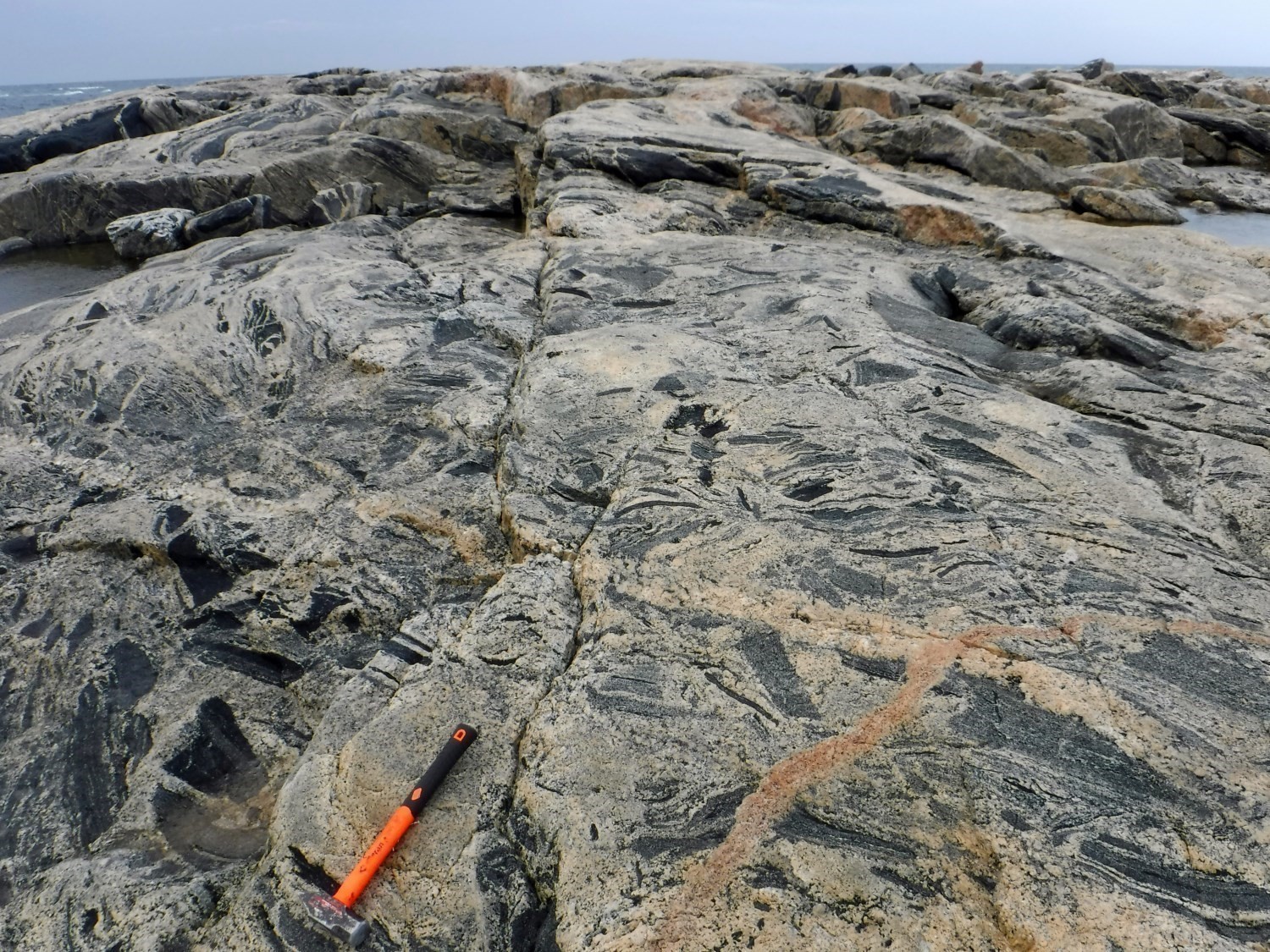
Last modified: 6 November 2019
Translation of original French
| Author: | Charette and Beaudette, 2018 |
| Age: | Paleoproterozoic |
| Reference section: | None |
| Type area: | None |
| Geological province: | Churchill Province |
| Geological subdivision: | Ungava Orogen / Narsajuaq Lithotectonic Domain |
| Lithology: | Tonalitic intrusive rock |
| Type: | Lithodemic |
| Rank: | Suite |
| Status: | Formal |
| Use: | Active |
None
Background
The Kimmuangajuq Suite was introduced by Charette and Beaudette (2018) to group biotite-schlieren tonalitic mobilisates. Prior to the work of these authors, these lithologies were not distinguished from the Older plutonic suite and the Younger plutonic suite of the Narsajuaq Lithotectonic Domain described by St-Onge and Lucas (1992) and St-Onge et al. (1992). Dunphy and Ludden (1998) recognized a monzogranitic to syenogranitic anatectite suite within the arch. Charette and Beaudette (2018) associated this anatectic suite with late-orogenic potassic intrusions included in the Sanningajualuk Suite.
Description
Kimmuangajuq Suite 1 (pPkimz1): Mobilisate-Type Whitish Tonalite Containing Biotite Schlierens
Unit pPkim1 consists of tonalite interpreted as an evolved mobilisate which, in outcrop, occurs in either heterogeneous masses or highly injected zones (50-70% injections) within orthogneiss and paragneiss. Tonalites of unit pPkim1 are characterized by a whitish to pinkish white altered surface, a weak foliation or massive appearance, and the presence of 5-15% millimetric to centimetric biotite schlierens or clusters. They vary in zones or bands from medium to coarse grained, giving the rock a slight heterogeneous appearance. The distribution of ferromagnesian minerals is generally heterogeneous, although homogeneous diffuse zones are present within the tonalite. The principal ferromgnesian mineral is biotite, which occurs as laminae or clusters with apatite, opaque minerals and locally epidote, allanite and sphene. Garnet is observed locally.
Lithologies of unit pPkim1 are generally tonalitic although locally granitic. This compositional change appears to be correlated with the composition of the host rock in which the mobilisate occurs. Typically, enclaves and diffuse horizons of tonalite, diorite or paragneiss are present and can account for up to 50% of outcrops. In close proximity to them, ferromagnesian minerals become more important within the pPkim1 tonalite, indicating assimilation of these enclaves.
Thickness and Distribution
Whitish tonalite of the Kimmuangajuq Suite forms small, elongated and folded intrusions following the E-W oriented regional tectonic grain. These are generally <2 km thick and are located near or within orthogneiss of the Sainte-Hélène Complex and paragneiss of the Erik Cove Complex. They also occur as decimetric to metric intrusions subconformable to or cutting the orthogneiss and paragneiss.
Dating
None.
Stratigraphic Relationship(s)
The Kimmuangajuq Suite is interpreted as ultrametamorphic granite-type mobilisate primarily resulting from partial melting of felsic to intermediate gneiss of the Sainte-Hélène Complex and paragneiss of the Erik Cove Complex. These orthogneiss and paragneiss are observed as enclaves (paleosome rafts or restitic enclaves) within the whitish intrusions of unit pPkim1. These tonalitic intrusions are cut by late granites of the Sanningajualuk Suite.
Paleontology
Does not apply.
References
| Author(s) | Title | Year of Publication | Hyperlink (EXAMINE or Other) |
|---|---|---|---|
| CHARETTE, B. – BEAUDETTE, M. | Géologie de la région du cap Wolstenholme, Orogène de l’Ungava, Province de Churchill, sud-est d’Ivujivik, Québec, Canada. Ministère de l’Énergie et des Ressources naturelles, Québec; BG 2018-03. | 2018 | BG 2018-03 |
| DUNPHY, J.M. – LUDDEN, J.N. | Petrological and geochemical characteristics of a Paleoproterozoic magmatic arc (Narsajuaq terrane, Ungava Orogen, Canada) and comparisons to Superior Province granitoids. Precambrian Research, volume 91, pages 109-142. | 1998 | Source |
| ST-ONGE, M.R. – LUCAS, S.B. | New insight on the crustal structure and tectonic history of the Ungava Orogen, Kovik Bay and Cap Wolstenholme, Quebec. Geological Survey of Canada; Research in progress, Part C, Paper 92-1C, pages 31-41. | 1992 | Source |
| ST-ONGE, M.R. – LUCAS, S.B. – PARRISH, R.R. | Terrane accretion in the internal zone of the Ungava orogen, northern Quebec. Part 1: tectonostratigraphic assemblages and their tectonic implications. Canadian Journal of Earth Sciences; volume 29, pages 746-764. | 1992 | Source |


